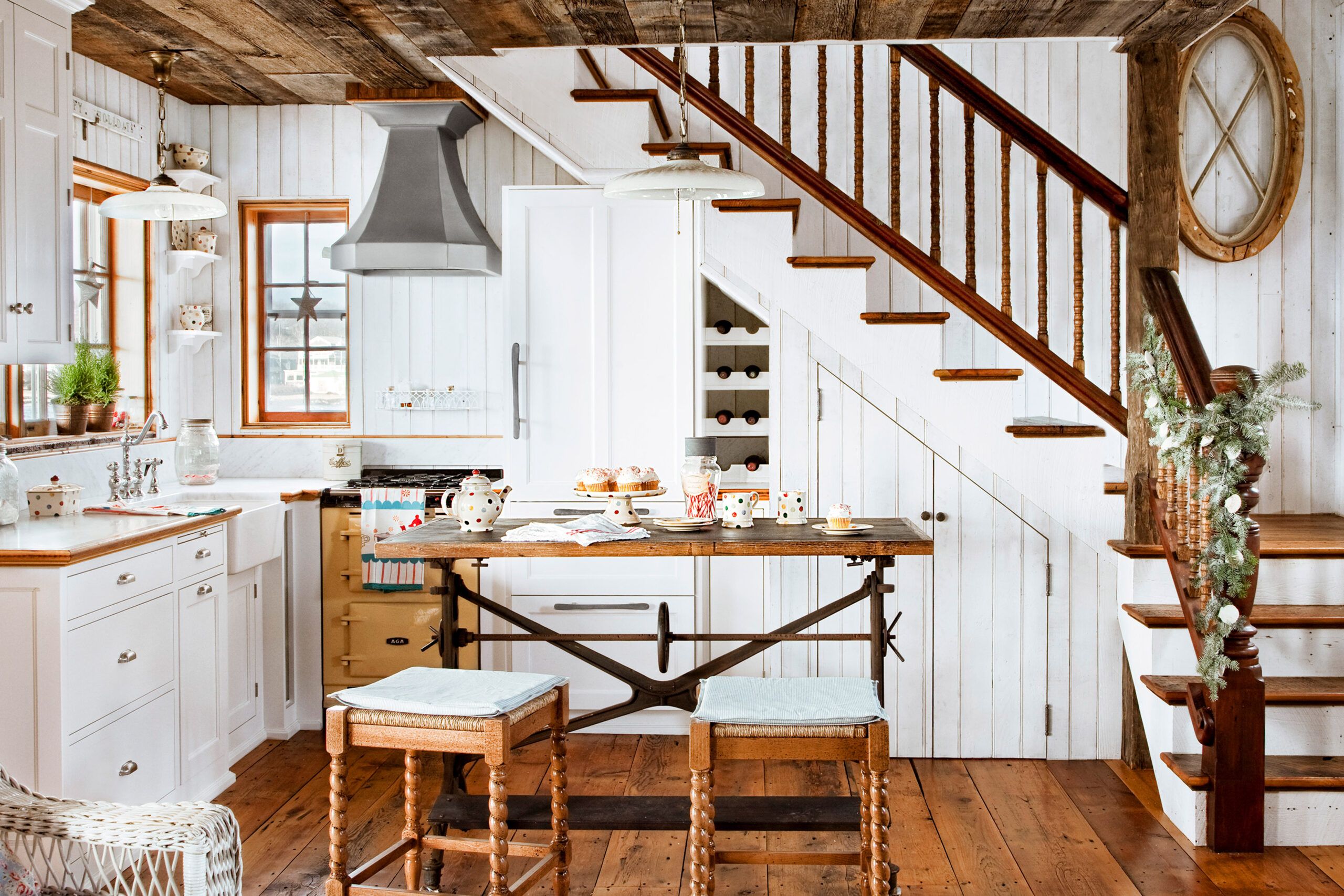Cottage-style interiors evoke a sense of warmth, comfort, and timeless charm. This design approach embraces a relaxed atmosphere that feels both inviting and lived-in. Whether you’re renovating an actual cottage or simply want to infuse your home with cozy cottage vibes, there are several key elements to consider. From rustic textures to vintage accents, let’s explore how to create a cottage-style interior with these easy steps.
Comfortable and Comforting
Cottage-style interiors strike a balance between airiness and intimacy, often featuring nooks and alcoves that serve dual purposes as cozy retreats and clever storage. The beauty of cottage-style lies in its ability to create a lived-in look that only improves with age.
Key features of cottage-style interiors include:
- Weathered finishes, from colorful painted surfaces to warm stained wood
- Vintage-inspired fixtures, fittings, and hardware
- Nostalgic touches that evoke a simpler time
- A mix of textures and patterns that add visual interest
By incorporating these elements, you can transform any space into a cottage-style haven that feels both refreshing and comforting. The charm of cottage style also often lies in its imperfections, where distressed finishes and eclectic designs come together to create a home that tells its own unique story.
Sturdy Walls
When it comes to cottage-style interiors, walls play a crucial role in setting the tone. Wood planks, such as beadboard, are an excellent choice for their durability and charm. These materials not only stand up well to everyday wear and tear but also add texture and character to your space. Whether it’s a kitchen, bedroom, or living room, walls can set the foundation for the cozy atmosphere you’re aiming to create.
Consider these options for your cottage-style walls:
- Painted beadboard in classic white for a bright, airy feel
- Shiplap for a more rustic, farmhouse-inspired look
- Textured wallpaper that mimics the appearance of wood planks
- Wainscoting to add architectural interest to plain walls
Handy Built-Ins
Built-in features are a hallmark of cottage-style design. These custom elements make the most of available space while adding character to your home. Built-ins can be tailored to fit any nook or cranny, turning potential wasted space into highly functional areas. Built-ins are also an excellent way to maintain a tidy visual appearance, hiding clutter behind closed doors or within concealed compartments.
In kitchens, consider incorporating built-in wine racks or storage cabinets tucked under stairs to maximize floor space. Use wood panels that match your cabinetry to soften the look of modern appliances. This technique helps integrate sleek stainless-steel appliances into the more traditional cottage aesthetic, creating a harmonious blend of old and new.
Warm Details
Small, warm details can add both visual interest and practicality to create a space that’s as functional as it is beautiful. The goal is to make the kitchen the heart of the home, a place where friends and family naturally gather.
Some key features to consider include:
- Bin pulls for drawers and cabinets
- A deep apron sink for a classic farmhouse look
- Vintage-style faucets with cross handles or lever designs
- Open shelving with decorative wood brackets
- Painted finishes in soft, muted colors
Handsome Floors
Flooring can play an important role in achieving the perfect cottage-style interior. Wood floors, whether stained or painted, add warmth and texture to any room. Wide pine boards are particularly well-suited to cottage design, showcasing their natural grain and character. The right flooring can set the stage for the rest of your decor, tying together your chosen color scheme and design elements.
Consider these flooring options for your cottage-style space:
- Reclaimed wood for an authentic, aged look
- Painted wood floors in soft, muted colors
- Wide-plank engineered hardwood for durability and style
- Distressed wood-look tile for high-traffic or moisture-prone areas
Built-Ins: Capitalized Space
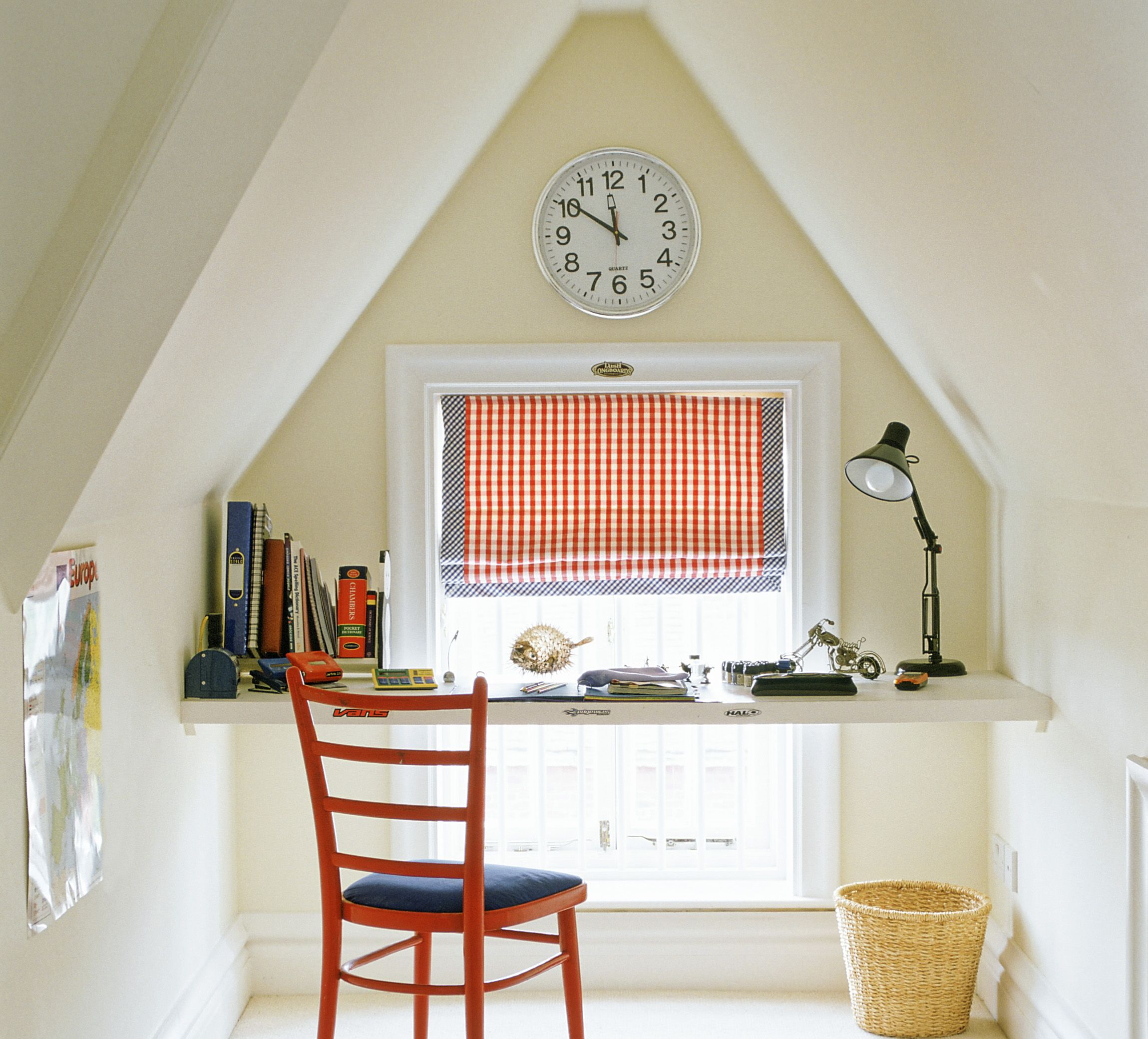
One of the hallmarks of cottage-style interiors is the clever use of space through built-in features. These custom elements not only maximize functionality but also add character and charm to your home. As you move through your cottage-inspired space, you’ll discover ingenious storage solutions and cozy nooks around every corner. These built-ins can be personalized to meet your unique needs, adding significant value to your home.
Dormer Desk
Even the smallest spaces can be transformed into functional areas with a bit of creativity. A simple built-in desk in a dormer area can turn an otherwise unused spot into a charming workstation. This adaptive reuse of space makes it easy to create a purposeful and pleasant work environment.
Here’s how to make the most of this space:
- Use wall cleats and sturdy boards to create a writing surface
- Choose a light-filled corner to maximize natural illumination
- Add a comfortable chair or stool for seating
- Incorporate small shelves or drawers for storage
- Decorate with cottage-style accessories like a vintage lamp or framed botanical prints
Built-Ins: Mini Mudroom
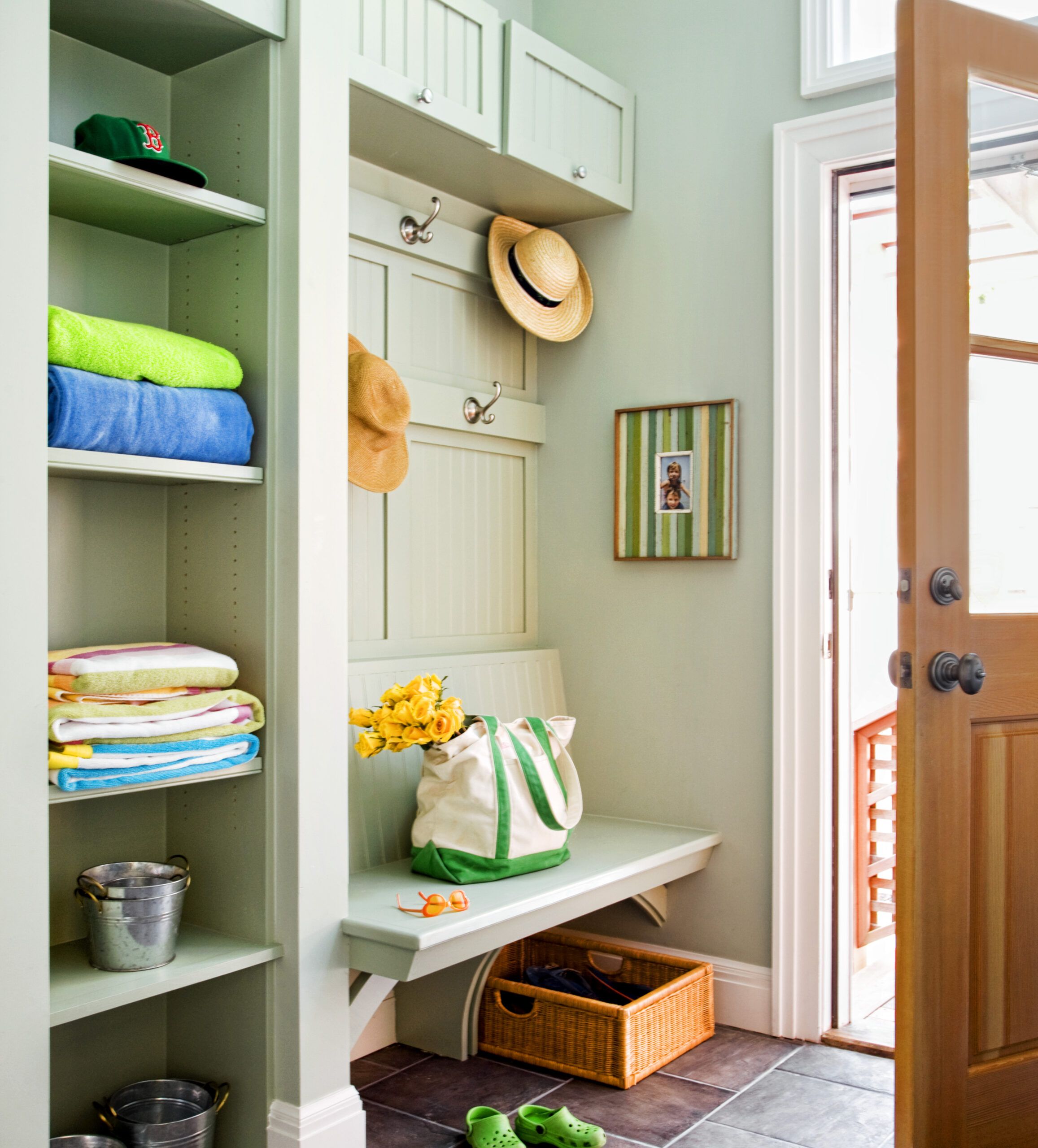
A mini mudroom is an excellent way to add both storage and style to an awkward entry space. This built-in feature combines practicality with cottage charm, creating a welcoming entrance to your home. It’s a great way to keep things organized and off the floor while adding a touch of rustic elegance.
Key elements of a cottage-style mini mudroom include:
- A tower of open shelves for baskets and decorative items
- Top cabinets with tilt-up doors for hidden storage
- A bench with curved supports for seating and shoe storage
- Simple battens with coat hooks for hanging jackets and bags
- Durable paneling that’s easy to clean and maintain
- A soft shade of paint to tie all the elements together
By incorporating these features, you can transform a small or awkward entry into an entry setup that can significantly simplify daily routines and management of coats, bags, and shoes.
Built-ins: Alcove Bunk Beds
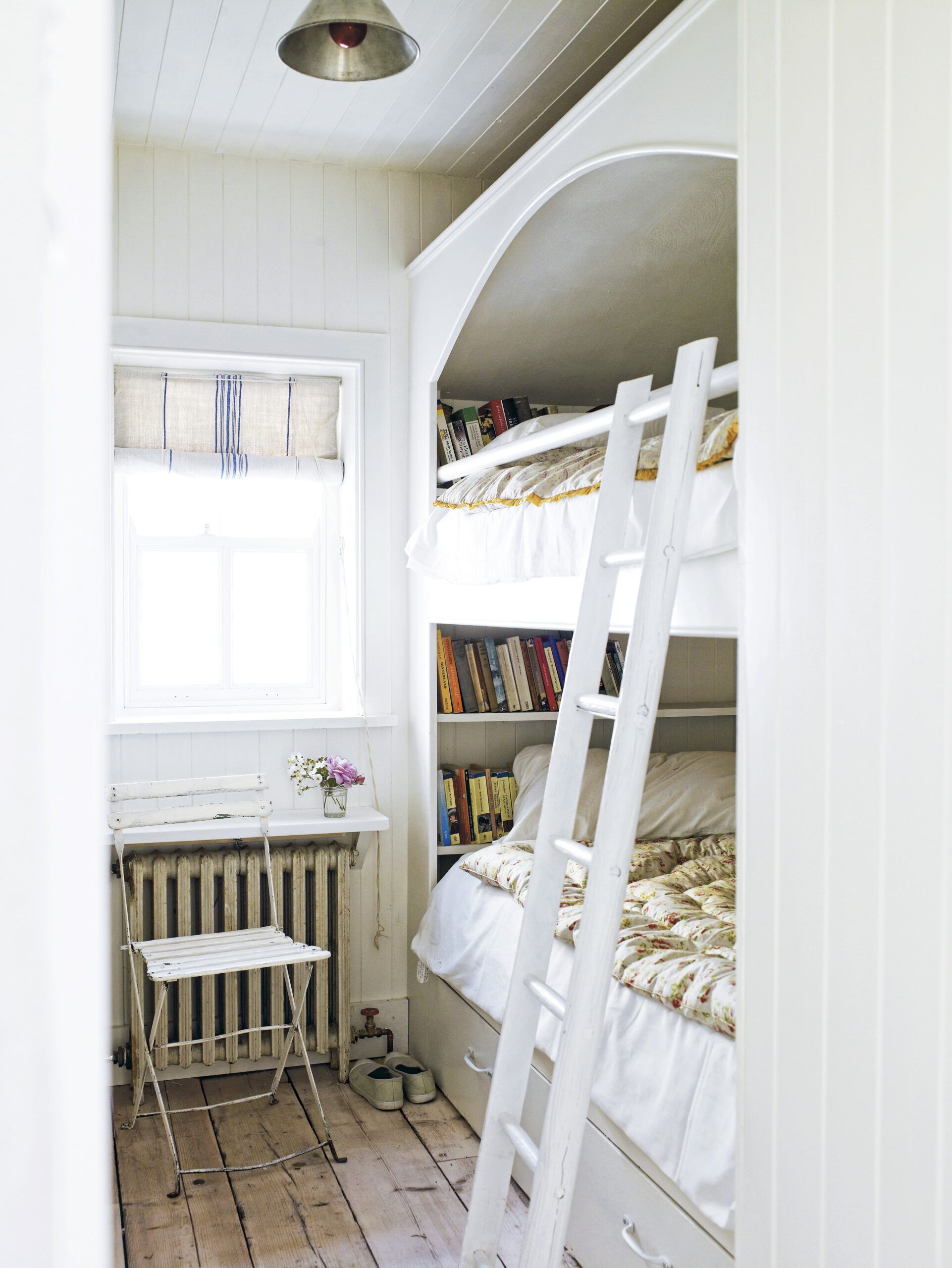
Bunk beds are a classic feature in cottage-style homes, especially in guest rooms or children’s bedrooms. An alcove design adds an extra layer of coziness and charm. Bunk beds can make great use of vertical space, providing additional sleeping areas without sacrificing valuable floor real estate.
Here’s how to create the perfect cottage-style bunk bed alcove:
- Use wood paneling to line the alcove for a warm, enclosed feeling
- Paint the alcove in a light color to keep the space bright and airy
- Add an arched enclosure for a whimsical touch
- Install shelves at the head of each bed for books and personal items
- Incorporate deep drawers under the lower bunk for extra storage
- Use cottage-style bedding with floral or gingham patterns
Built-Ins: Storage Niche
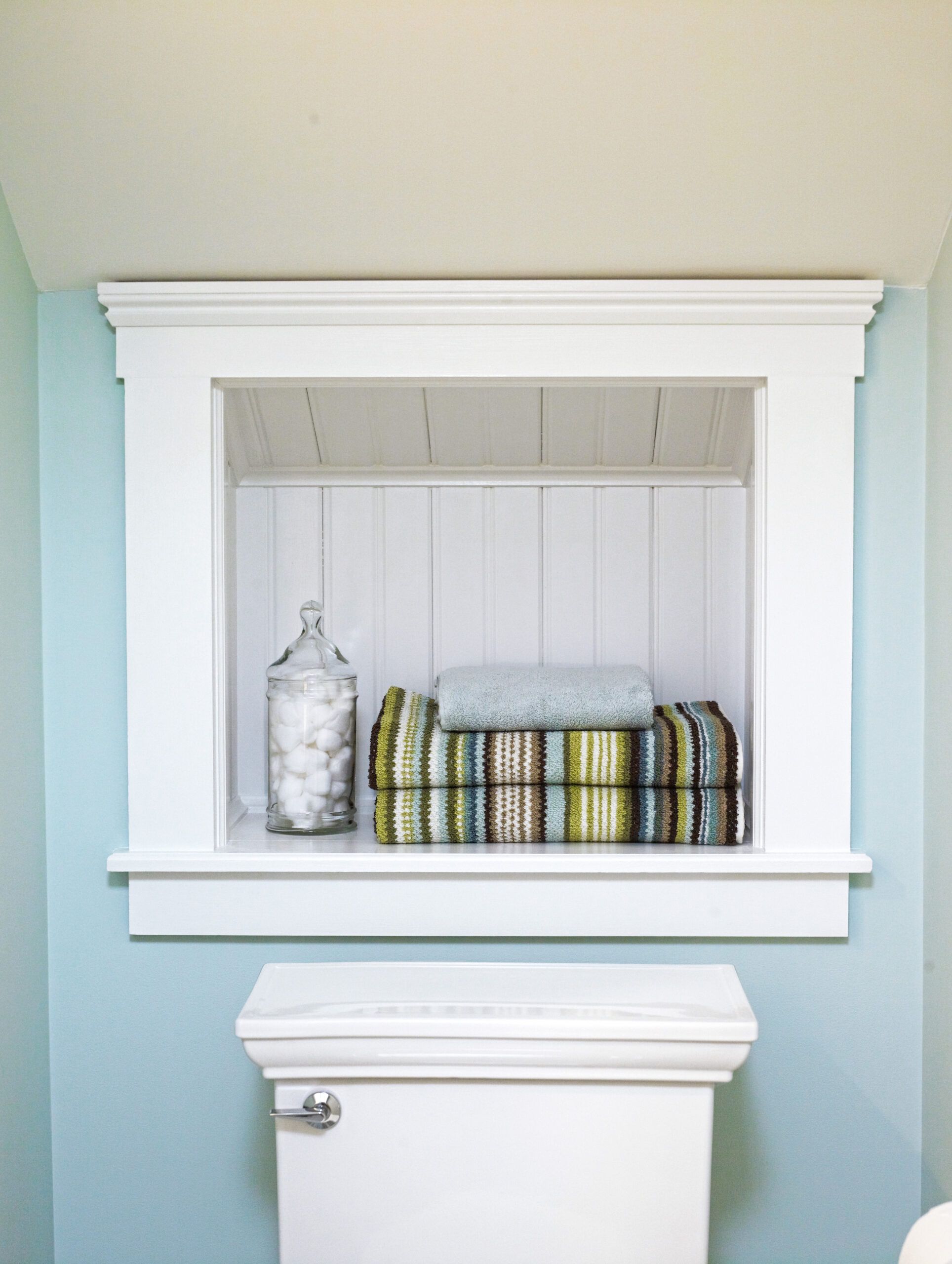
In cottage-style interiors, every inch of space is put to good use. These niches are not just functional, but also add a layer of architectural detail to otherwise plain walls.
Here’s how to create and style a cottage-inspired storage niche:
- Line the niche with beadboard for added texture and charm
- Trim out the edges to give it a finished, built-in look
- Use the space for storing extra towels in a bathroom or bedroom
- Add small baskets or decorative boxes for organizing smaller items
- Install a small light fixture to highlight the niche and its contents
These clever recesses are particularly useful in small spaces where additional storage can make a big difference and add personality to an otherwise plain nook.
Built-Ins: Away-From-It-All Bench
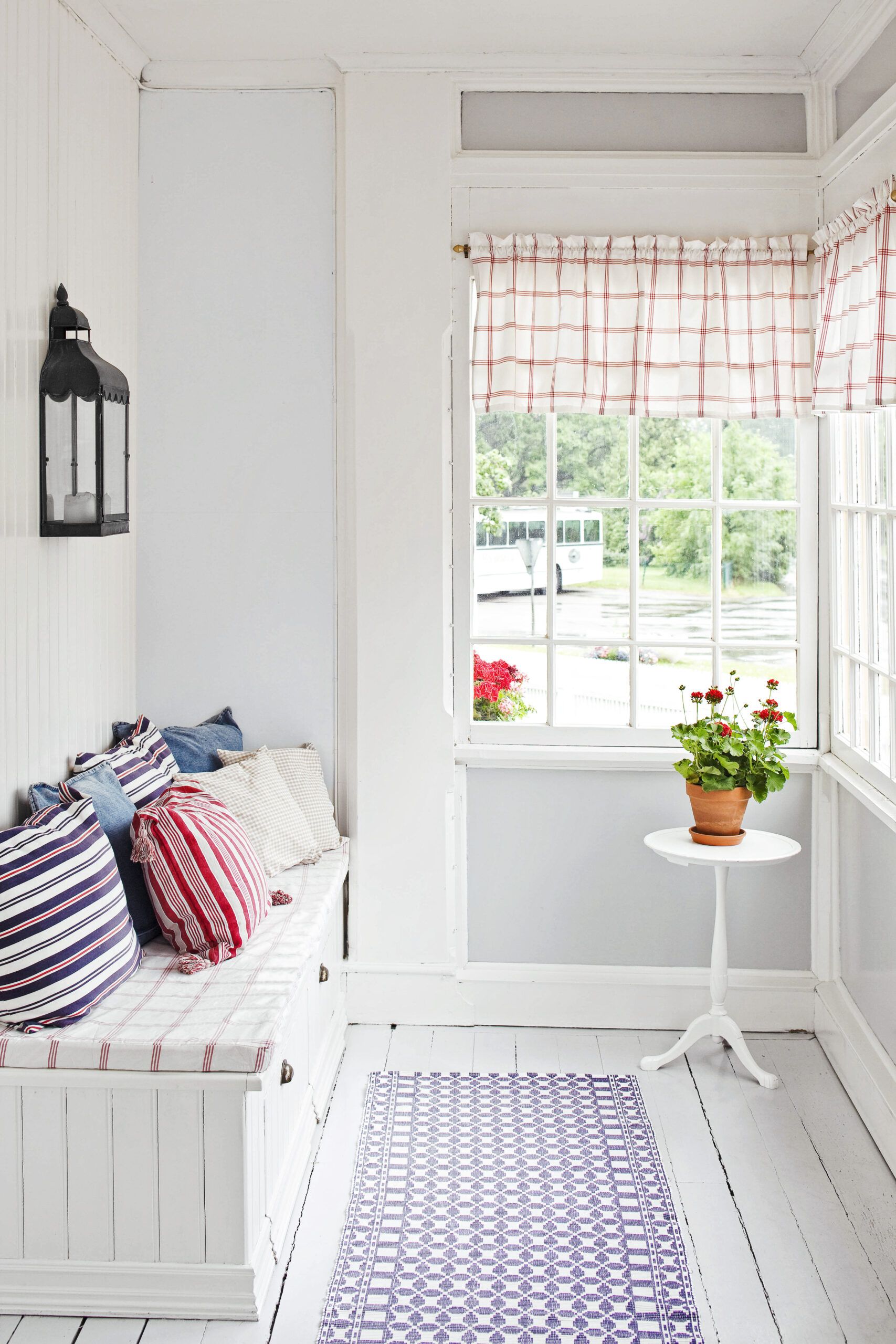
A built-in bench in a quiet corner or a three-season room can create a perfect retreat within your cottage-style home. This cozy nook offers a space for relaxation and contemplation. Such benches can also offer convenient hidden storage, keeping your space neat and organized.
Here’s how to design the perfect away-from-it-all bench:
- Build drawers underneath for hidden storage of outdoor decor or reading materials
- Add a comfortable cushion in a cottage-inspired fabric
- Include several throw pillows for extra comfort and style
- Place a small side table nearby for drinks or books
- Lay down a patterned rug to define the space and add warmth
- Position the bench near a window for natural light and views
This type of built-in serves as a multifaceted area where you can read, nap, or simply enjoy the view outside.
Painted Wood Floors
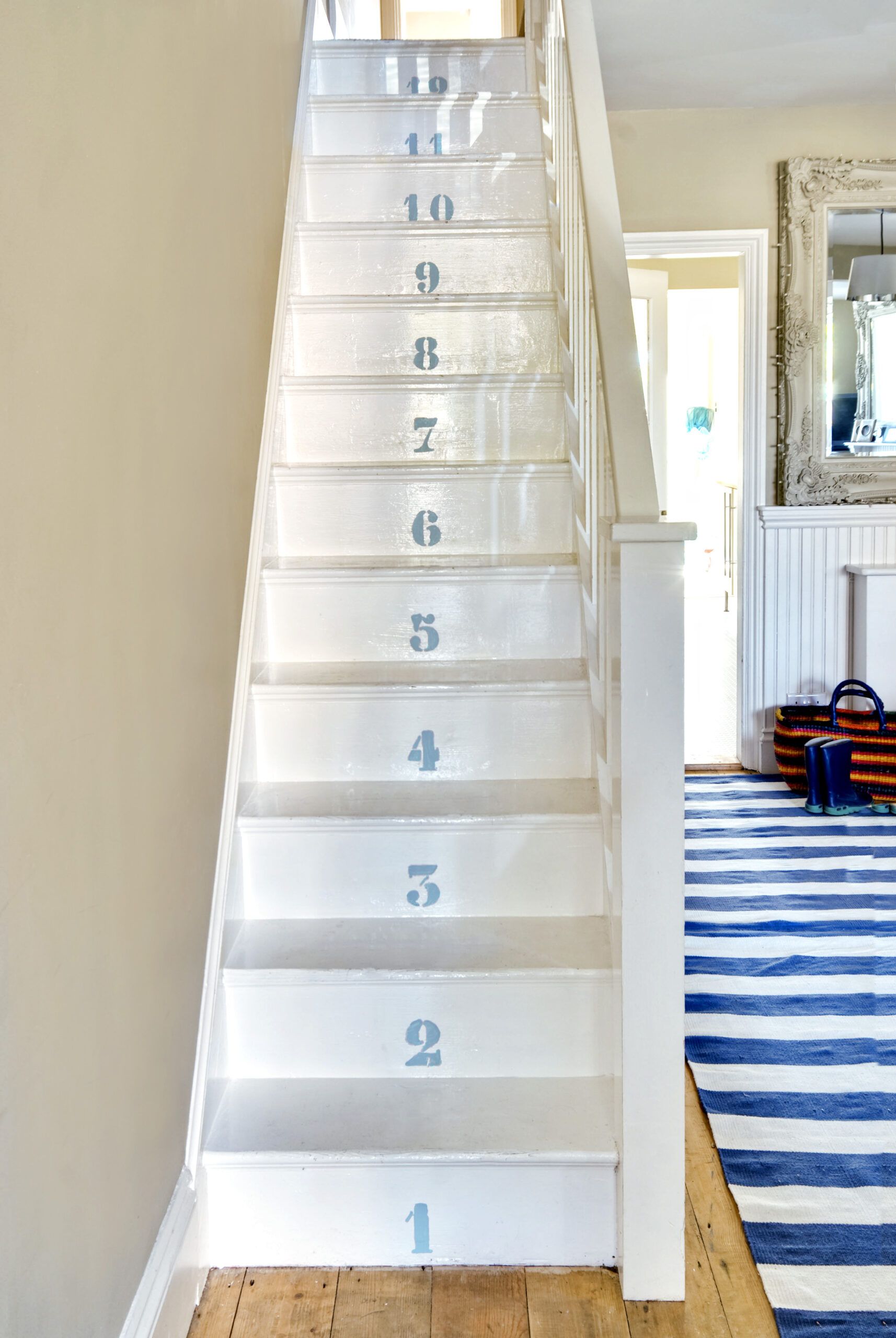
Painted wood floors are a hallmark of cottage-style interiors, adding character and charm to any room. This design choice allows for playful color and pattern underfoot, creating a lighthearted atmosphere. Painted floors also wear their age well, developing a beautiful patina over time that only enhances their appeal. The variety of colors and patterns available allows for endless customization to match your decor.
Spruced-Up Steps
Stairs offer a unique opportunity to add personality to your cottage-style home. With some attention to detail, your staircase can be a show-stopping feature of your home.
Here are some ideas for sprucing up your steps:
- Paint the staircase in fresh white to contrast with khaki walls and stained wood floors
- Stencil old-fashioned numbers onto each riser for a whimsical touch
- Use a durable paint designed for high-traffic areas to ensure longevity
- Consider adding a runner in a cottage-inspired pattern for added comfort and style
These simple updates can transform your staircase into a focal point that embodies the charm of cottage living.
Painted Wood Floors: Extended Up The Walls
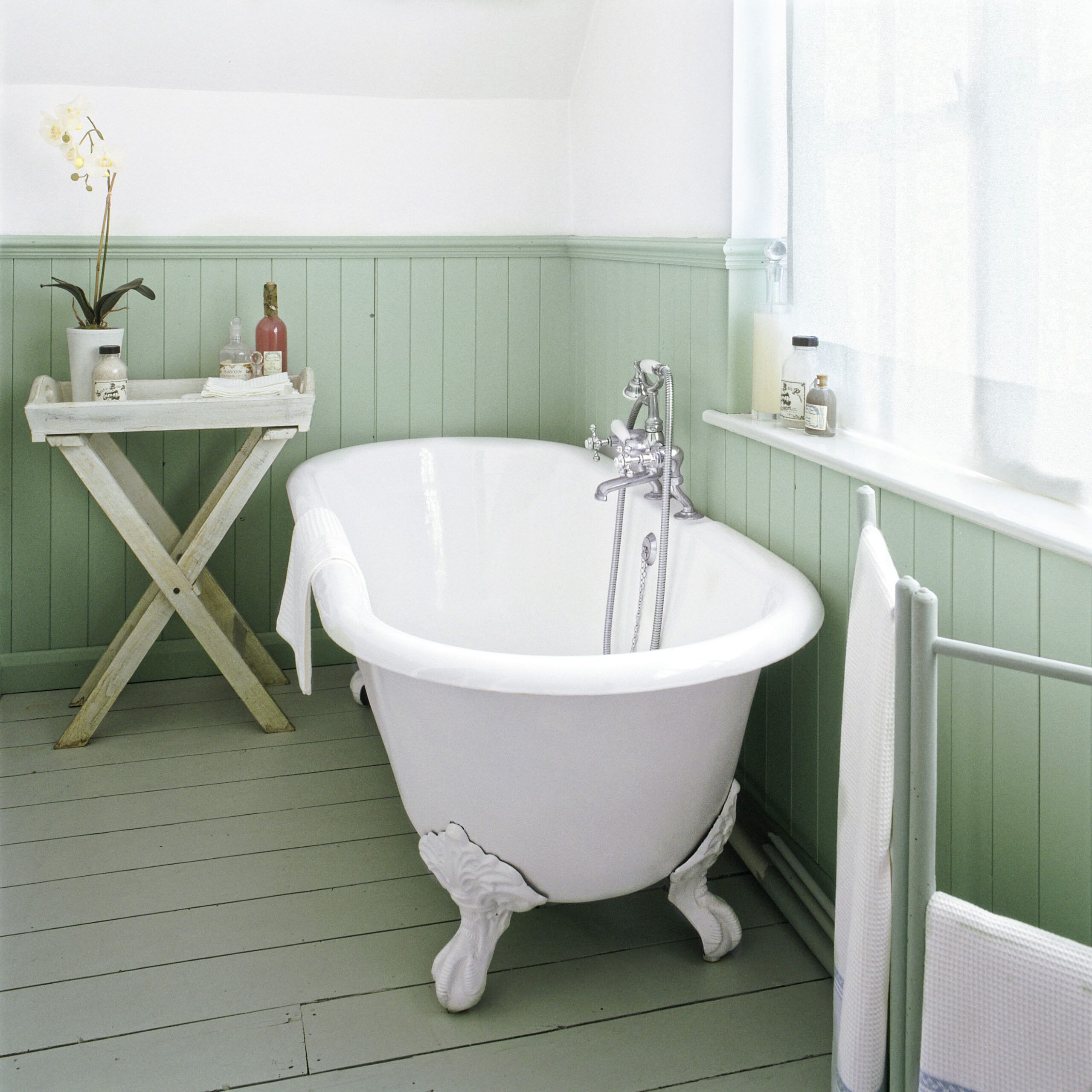
For a cohesive look, consider extending the color of your painted wood floors up onto the walls. This technique creates a seamless, enveloping effect that’s particularly effective in smaller rooms like bathrooms. Extending the floor color up the walls can also make the ceiling appear higher, adding to the perceived space in the room.
Here’s how to achieve this look:
- Choose a soothing color like sage green for both floors and walls
- Paint baseboards and wainscoting in the same hue
- Use a semi-gloss finish for easy cleaning and a subtle sheen
- Keep the ceiling white to maintain an open, airy feeling
- Add natural elements like woven baskets or wooden accessories to balance the painted surfaces
This approach not only unifies the space but also adds depth and interest to your cottage-style interior.
Painted Wood Floors: Colorful Checkerboard
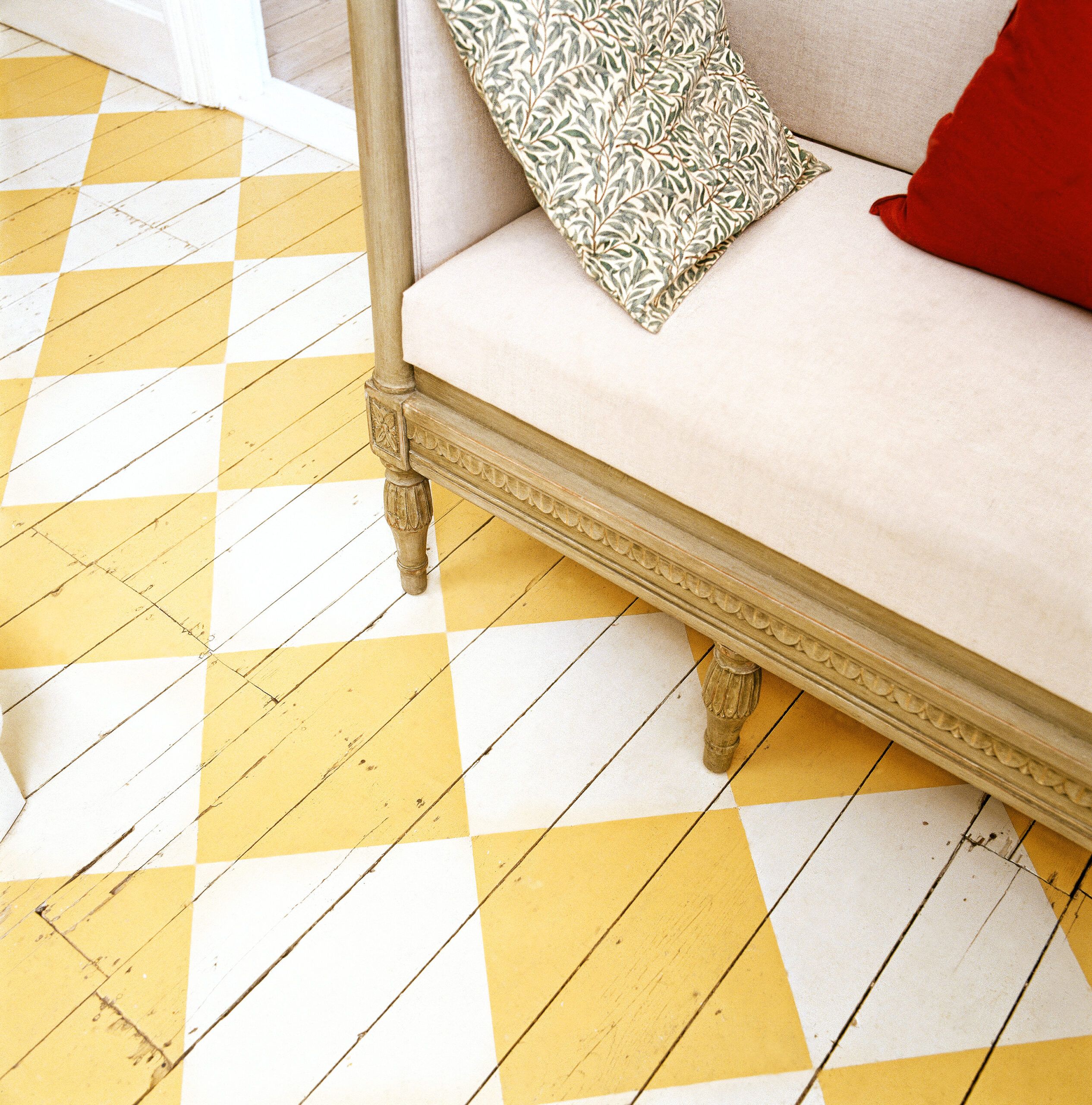
A painted checkerboard floor is a playful and eye-catching addition to any cottage-style home. Checkerboard floors evoke a sense of nostalgia and whimsy, perfect for a cozy cottage environment.
Here’s how to create and maintain a colorful checkerboard floor:
- Choose two complementary colors, such as sunny yellow and soft cream
- Use large squares for a bold, graphic look
- Apply a durable floor paint to withstand foot traffic
- Seal the painted surface with a clear coat for added protection
- Touch up as needed to keep the pattern looking fresh
Remember, painted floors are an excellent way to disguise flaws in old floorboards, making them a stylish choice for cottage interiors. They can also be an opportunity to express your style and bring a touch of fun into your home decor.
See more in-depth step-by-step instructions for how to paint a checkerboard floor.
Planked Walls
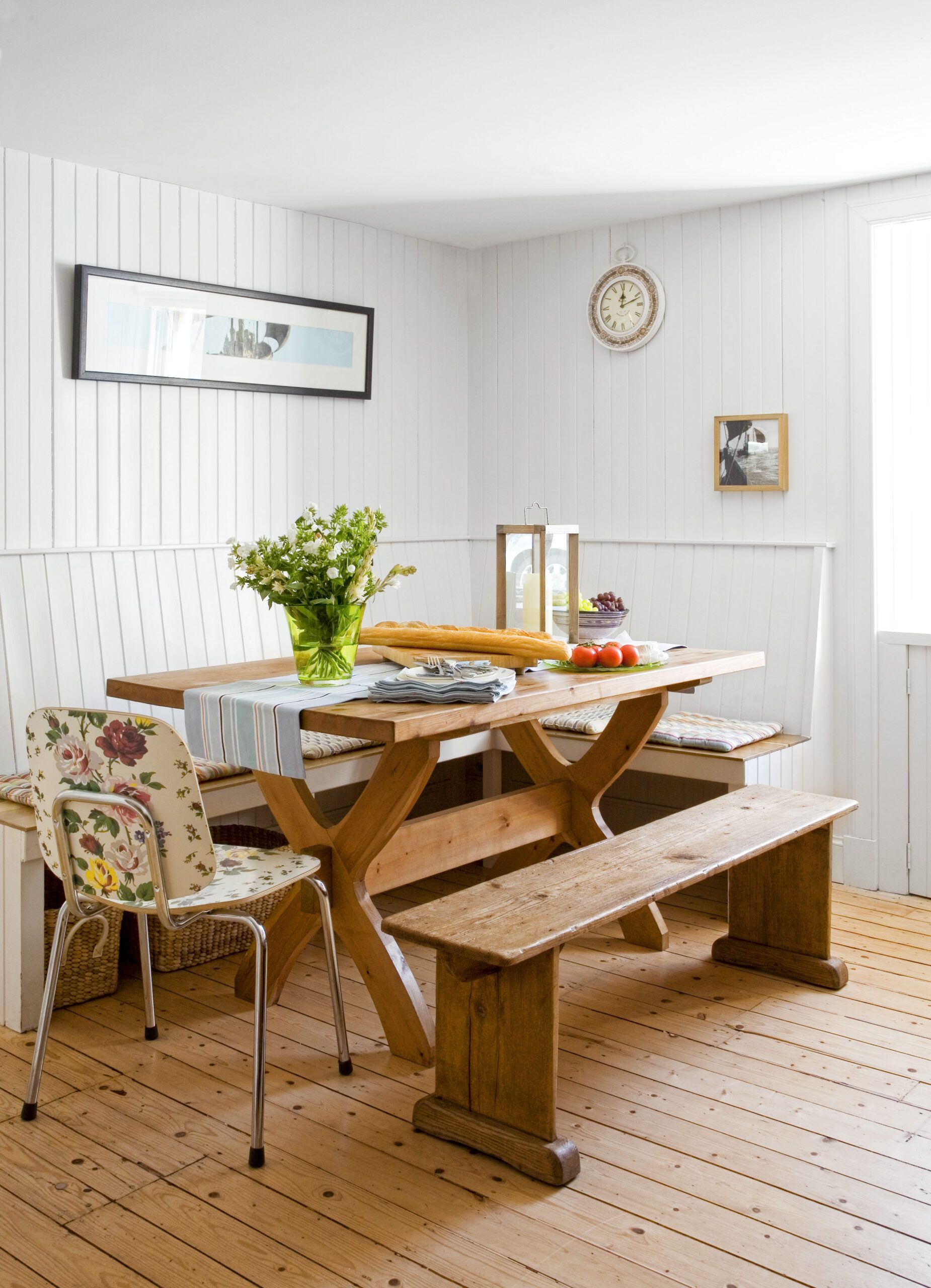
Planked walls are a quintessential element of cottage-style interiors. Originally used as an affordable and durable wall covering in hardworking rooms, planked walls have endured due to their casual, homey charm. Today, they continue to be a popular choice for creating a cozy, cottage atmosphere in any home. They also provide texture and depth to your walls, making the space feel more layered and interesting.
To The Ceiling
Beadboard, a type of planked wall covering, gained popularity in Victorian times for use in kitchens, bathrooms, and work areas. When installed floor to ceiling, beadboard creates a striking visual impact that embodies the cottage aesthetic.
Here’s how to incorporate floor-to-ceiling beadboard in your space:
- Choose a traditional white paint to brighten the room
- Consider using beadboard on all walls for a cohesive look
- Extend the beadboard to built-in elements like banquettes for a seamless appearance
- Pair with simple trim work to enhance the cottage feel
- Use a semi-gloss finish for easy cleaning in high-traffic areas
Planked Walls: Wraparound Wainscoting
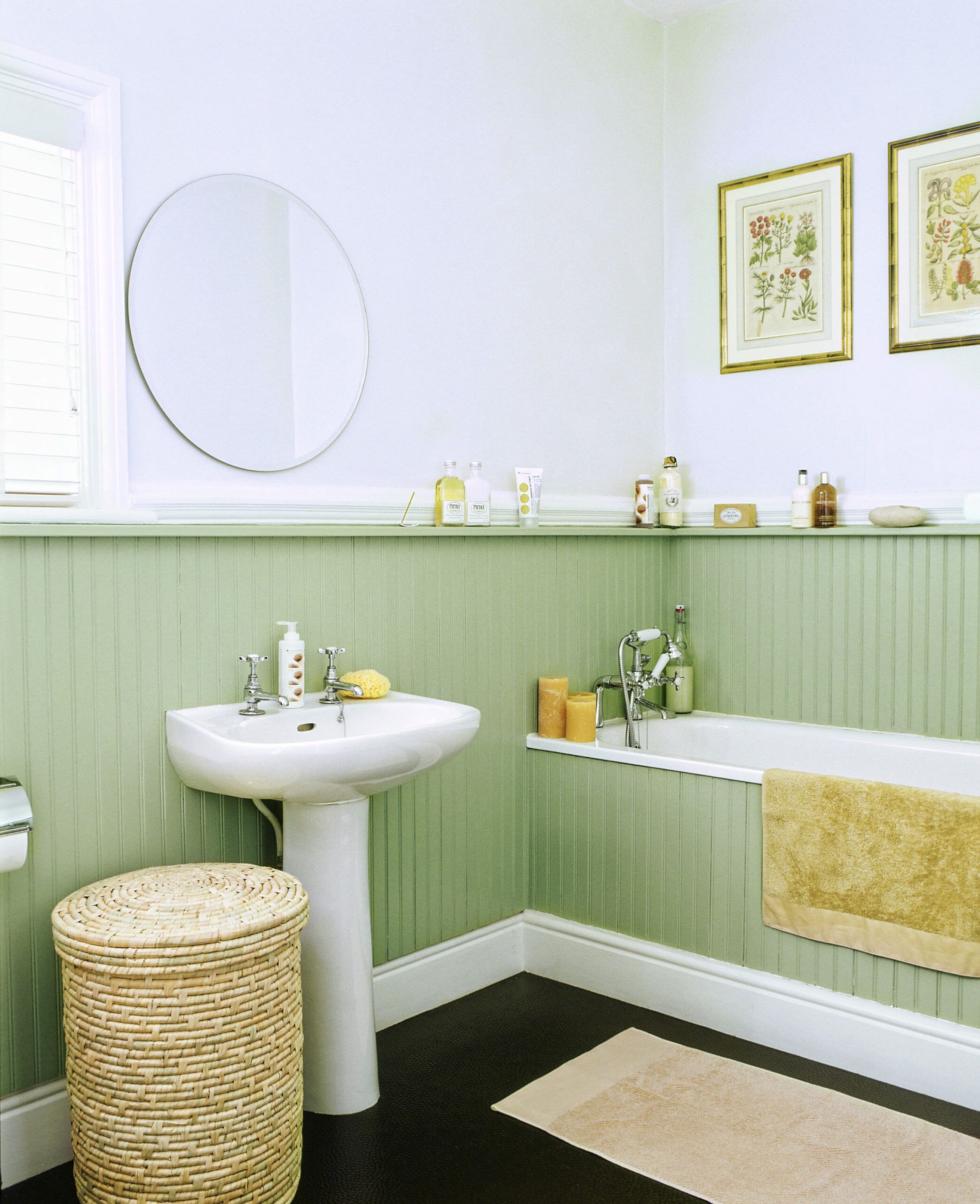
Wainscoting is another classic way to incorporate planked walls into your cottage-style interior. In bathrooms, wraparound wainscoting serves both decorative and practical purposes. It’s a way to add visual interest and protect walls from moisture and wear.
Here’s how to make the most of this design element:
- Install beadboard wainscoting at chair-rail height around the room
- Cap the wainscoting with a flat rail that doubles as a shelf for toiletries
- Extend the wainscoting to wrap around the bathtub for a built-in look
- Paint the wainscoting in a cheerful color like spring green
- Use the same color on the tub surround for a cohesive appearance
- Keep the upper walls and ceiling white to maintain an open feel
The continuous wainscoting can provide a uniform look that ties together various elements in the room.
Planked Walls: Run Side to Side
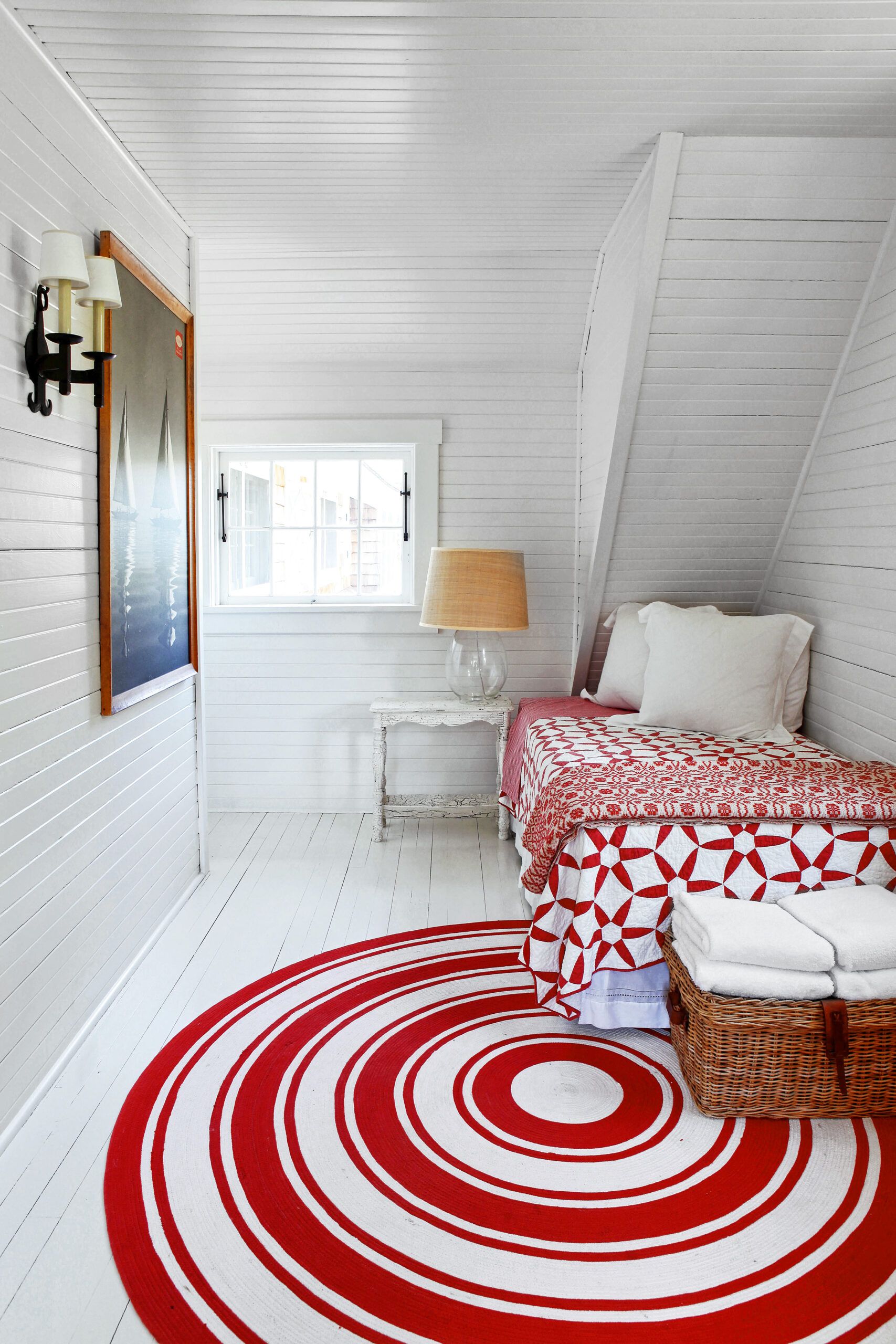
While vertical planks are traditional, running planks horizontally can be an effective way to visually expand a space. This technique is particularly useful in long, narrow rooms like bedrooms. Horizontal planks can make the room appear wider and give the walls a more dynamic look.
Here’s how to implement horizontal planked walls in your cottage-style space:
- Install wide planks horizontally to emphasize the room’s length
- Use the same planks on the ceiling to create a sense of enclosure
- Paint all planks in a uniform color, such as white, for a bright, airy feel
- Consider a light, warm-toned wood for a natural look
- Pair with simple, cottage-style furnishings to complete the look
This approach to planked walls can make a small space feel larger while maintaining a cozy atmosphere.
Vintage Details

Incorporating vintage details is key to achieving an authentic cottage-style interior. These elements add character, charm, and a sense of history to your space. Well-crafted and practical, period-look woodwork, fixtures, fittings, and hardware contribute to the informal, lived-in feel that defines cottage style. Vintage details can make your home feel curated and lived-in, adding to its overall warmth and inviting atmosphere.
Open Shelves
Open shelving is a hallmark of cottage-style kitchens. These shelves allow you to display everyday items and cherished collectibles, making your kitchen personal and welcoming.
Here’s how to incorporate open shelves into your cottage kitchen:
- Use oversized brackets for a handcrafted feel
- Install screw-in hooks underneath for hanging mugs or utensils
- Display everyday dishes for easy access and a lived-in look
- Mix in vintage pieces or colorful ceramics for added charm
- Keep the shelves styled but not overcrowded for a casual feel
Open shelves can bring a sense of openness and accessibility to the space, making it feel lighter and more informal.
Vintage Details: Wall-Hung Storage
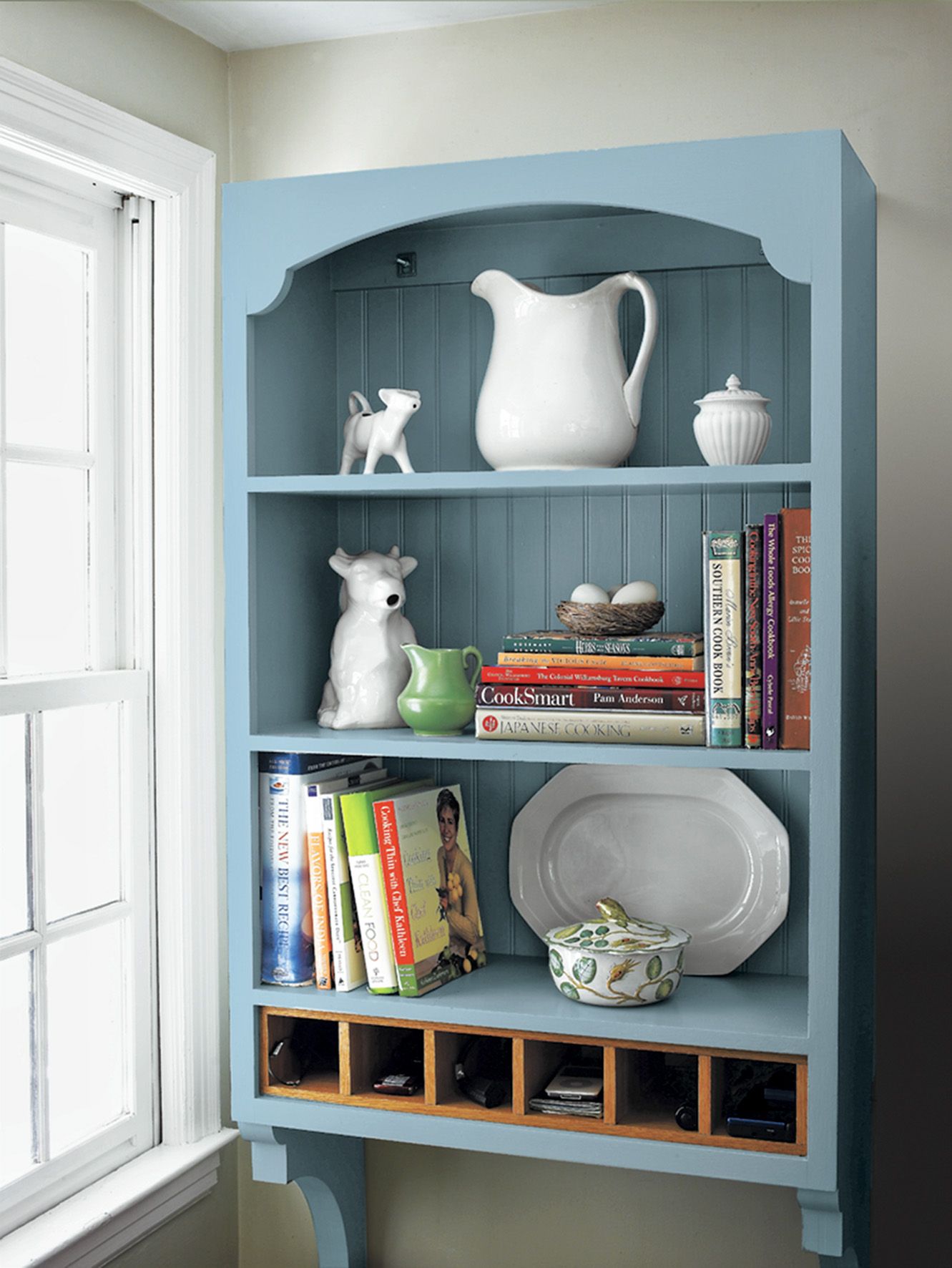
Wall-hung storage units are a space-saving solution that fits perfectly with cottage style. These pieces harken back to a time when kitchens were smaller and every inch of space was utilized efficiently.
Here’s how to incorporate wall-hung storage into your cottage interior:
- Choose a piece with a graceful arch and curved brackets for traditional appeal
- Look for units with a beadboard back to tie in with other cottage elements
- Opt for a combination of open shelves and enclosed storage
- Use the open shelves to display pretty dishes or collectibles
- Store less attractive items behind doors or in baskets
- Consider adding a built-in cubby organizer for modern functionality
The combination of open and closed storage allows you to keep your favorite items in view while tucking away others for a neat and organized look.
Vintage Details: Interior Shutters
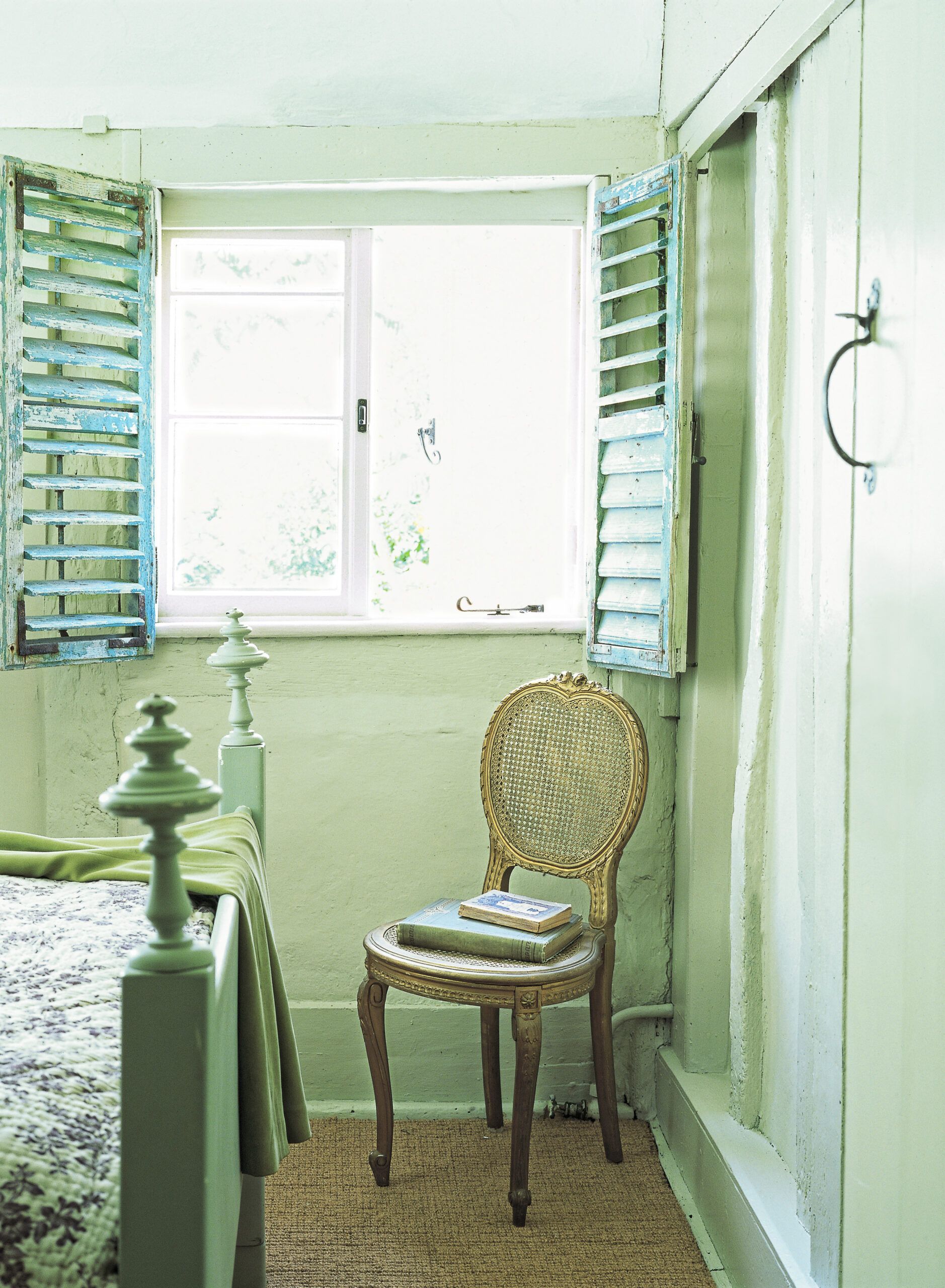
Originally, operable shutters were used to keep out the sun. Today, they’re both functional and decorative. The well-worn paint finish on this pair adds a rustic touch of texture in a simple bedroom. These kinds of shutters allow you to both add a level of rustic charm to your window-side sitting area and add a level of control to the room’s light level.
Here’s a quick overview of how to incorporate these shudders into your home:
- Search for a set of shutters that match the interior look of your room.
- Purchase a set of hinges.
- Install hinges on the inside section of your window frame.
- Install new shutters onto hinges.
Vintage Details: Wire Door Panels
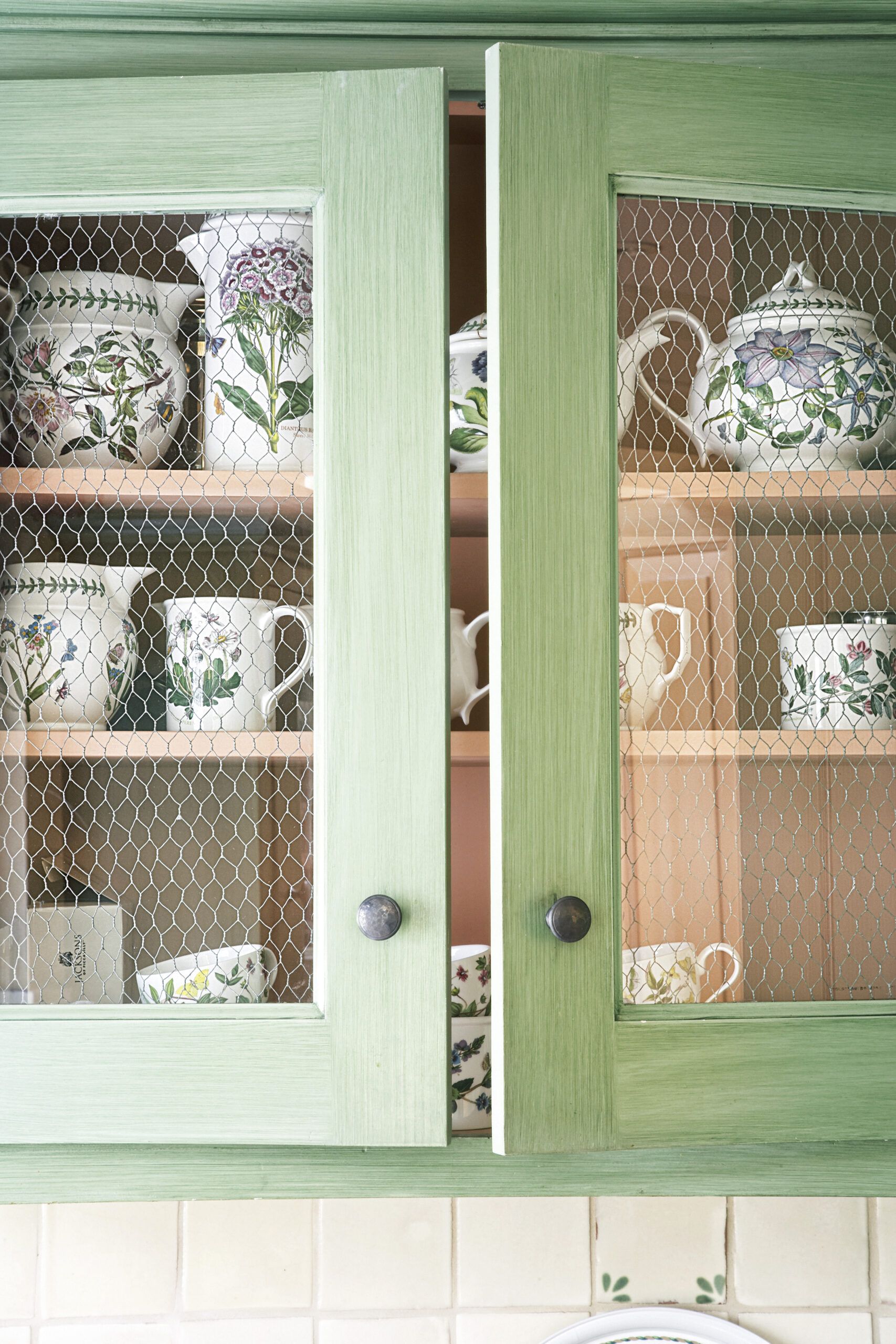
Chicken wire was originally used on pantry doors to let air circulate around stored root vegetables. Installed behind glass fronts, it provides a hint of country charm. This niche material has seen a modern resurgence in cabinet design. Nowadays, you can find cabinets incorporating chicken wire into their doors, creating a vintage and midwestern look.
Alternatively, you can add chicken wire to existing cabinets by purchasing a new set of cabinet door frames, stapling chicken wire to the inward-facing side, and installing them in place of your existing doors.
Vintage Details: Cast-Iron Sink
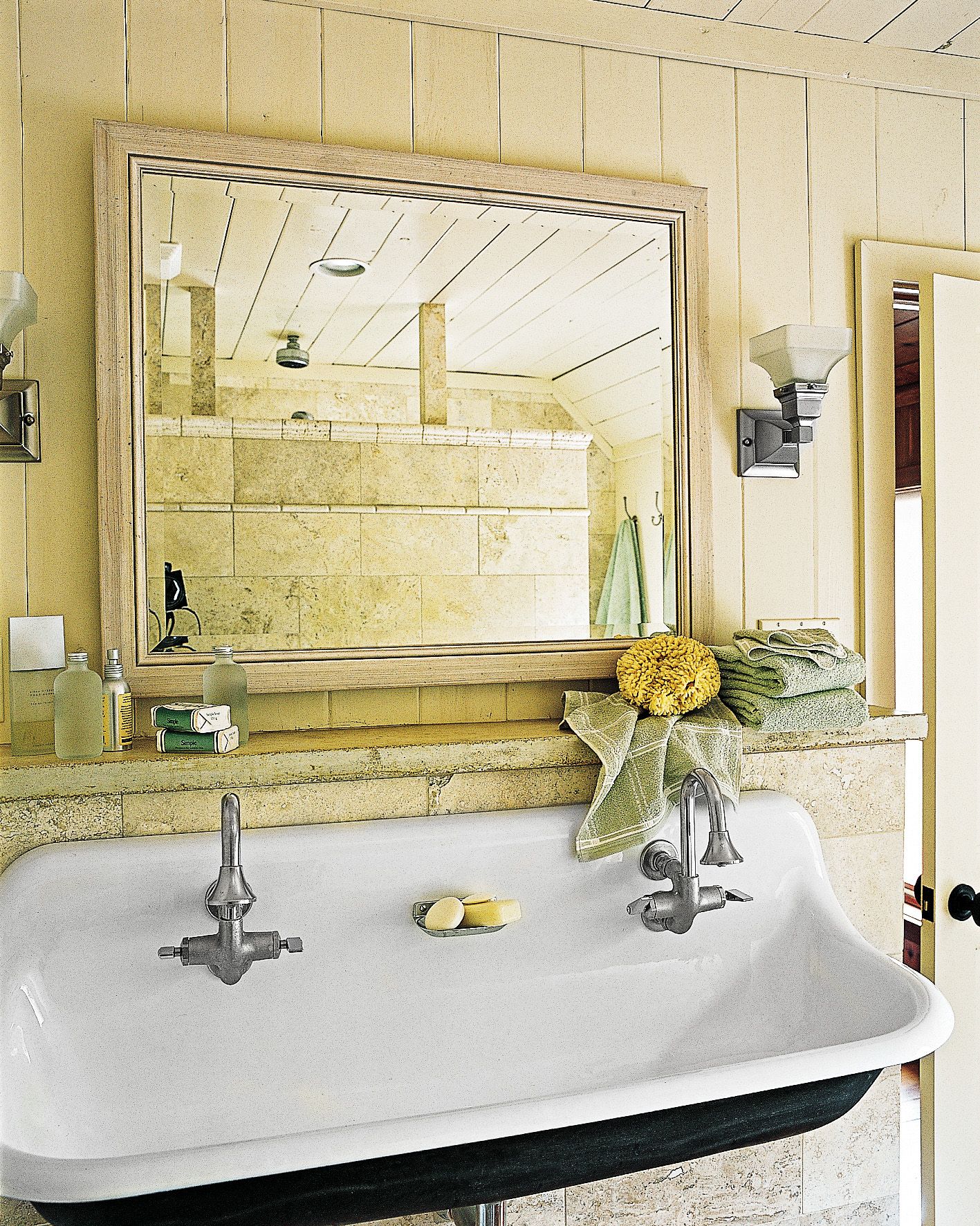
Swooping basins with built-in backsplashes and wall-mounted faucets have a handsome utilitarian look. This oversized double sink anchors a shared bath, offering plenty of room for cleanup after a day’s work. The shelf below the mirror makes up for the lack of deck space.
Cast iron sinks can be a great choice for some vintage-styled bathrooms. However, you’ll need to take some extra steps to ensure they don’t rust or degrade more quickly inside your bathroom. Cast iron sinks aren’t seen in bathrooms as much due to how easily iron rusts. If you purchase one of these sinks, be sure it’s fully enameled, which will help protect it from corrosion.
Vintage Details: Claw-Foot Tub
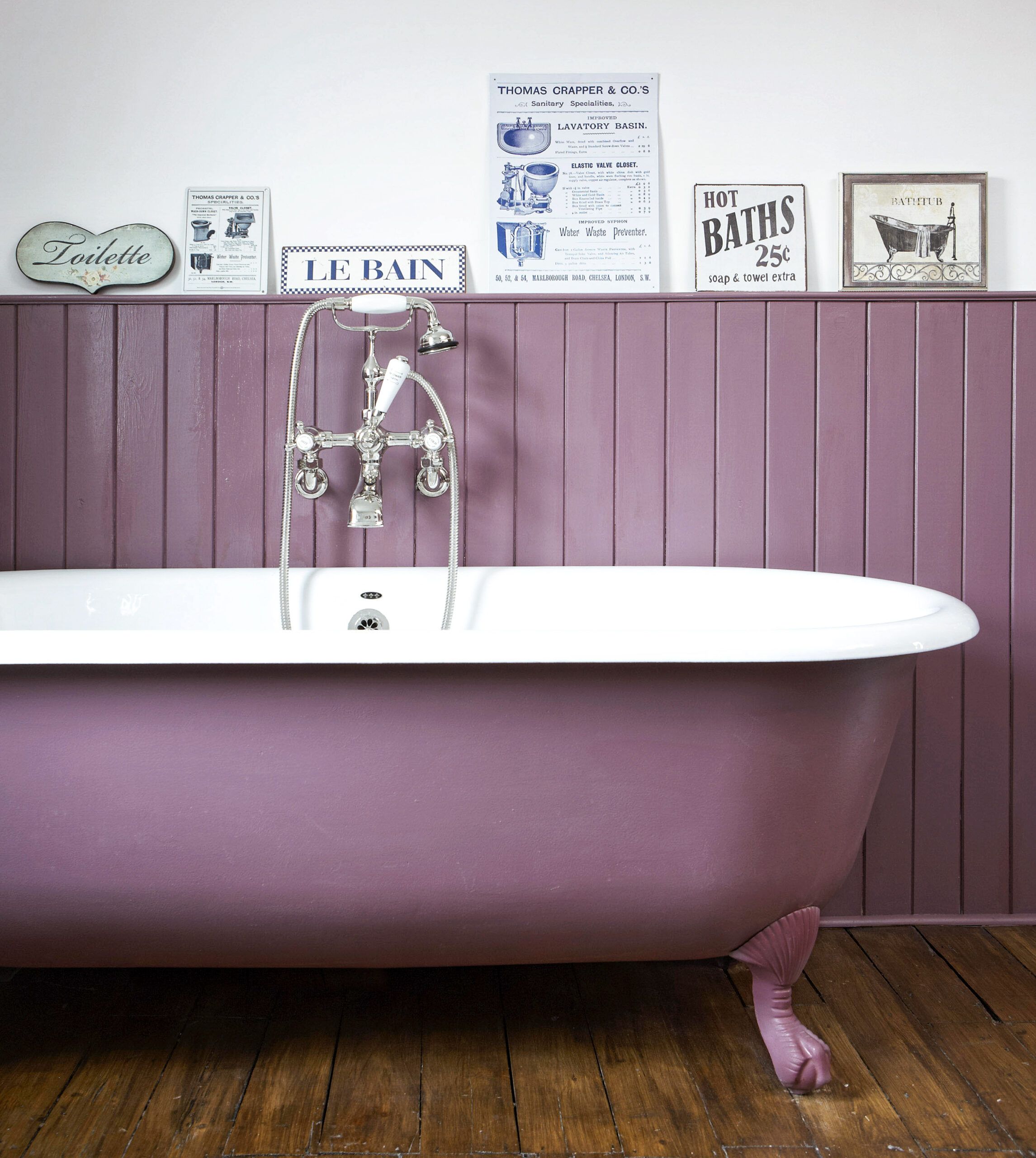
Elevated on ball-and-claw feet, an old-school soaker in porcelain-coated cast iron might just be the height of laid-back style. Plum paint, used on this tub’s sides and on the surrounding wainscoting, gives it an updated look that’s right at home with dark-stained wood floors.
While claw-foot tubs can be a great cottage-style addition to most bathrooms, there are some things you should be aware of before purchasing one. First, claw foot tubs are much heavier than traditional installations, meaning you’ll need to check your bathroom’s load-barring capability before buying. Second, since they’re not directly installed into the wall like normal tubs, you may need to hire a plumber to redirect piping into the tub.
Vintage Details: Wood Peg Rail
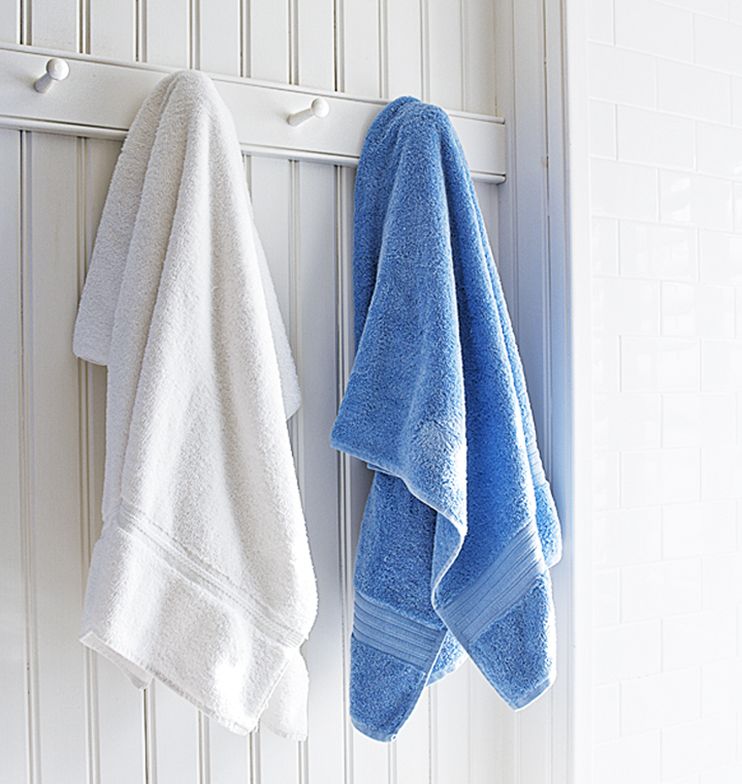
In a bath, it’s a fuss-free way to hang towels — just toss them there to dry. Throughout the house, peg rails can function as both millwork accents and storage solutions for everything from dishcloths to backpacks. Adding these old-fashioned additions to a bathroom, mud room, or entryway is simple, and most home improvement stores offer them for purchase.
